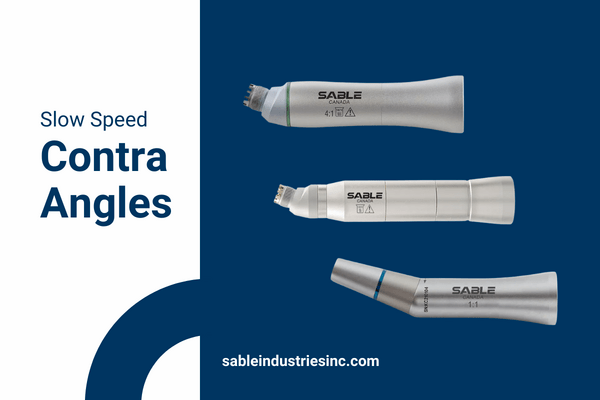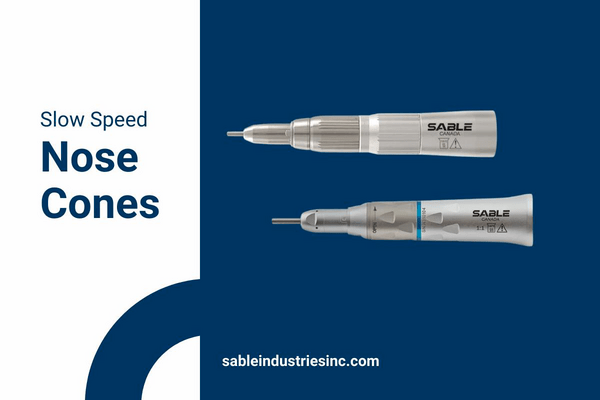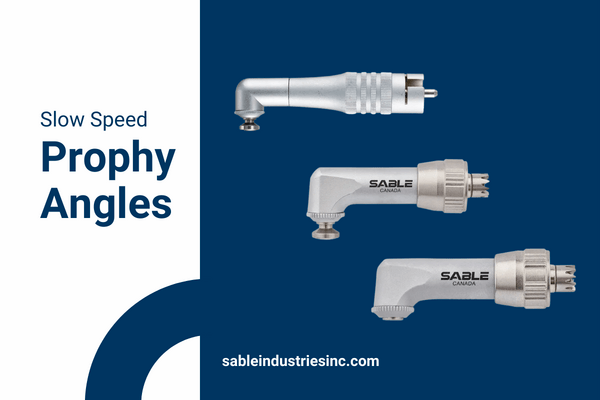The attachment you choose for your slow speed dental handpiece is a key decision.
There are many types of attachments for different tasks. Choosing the right attachment improves the speed of the procedure, its outcome, and even the comfort of you and your patient.
Here’s what you need to know about choosing your slow speed handpiece contra angles, straight angles/nosecones, and prophy angles depending on your needs.
- Anatomy of a Slow Speed Handpiece
- What are Slow Speed Angles?
- Types of Slow Speed Angles
- Contra Angles
- Straight Angles
- Prophy Angles
1. Anatomy of a Slow Speed Handpiece
Slow speed handpieces are precision tools dental practitioners use to remove cavities, perform restorative work, prepare teeth for crowns, fillings, and veneers, and other orthodontic work.
In contrast to high speed handpieces, which run at 350,000 to 500,000 RPM, slow speeds run at 20,000 RPM (air driven) and 40,000 RPM (electric). The difference in operating speed means that slow speed handpieces generally have a longer lifespan and require less maintenance and repair than high speeds.
As with high speed handpieces, slow speed handpieces connect to your dental unit via either a fixed back or quick disconnect connection. However, unlike high speed handpiece connections, slow speeds generally only have two possible tube configurations: 2 holes or 4 holes.
Many slow speed handpieces are versatile and can be equipped for a variety of procedures and purposes by attaching different angles. These angles extend the use of a slow speed handpiece, allowing you to perform more work efficiently with a single piece of equipment.
Slow speed handpieces also come with a variety of different chucking mechanisms that determine how the bur is retained and changed. These attachments also change the utility of the handpiece and are one of the most basic decisions you must make when choosing a slow speed handpiece.
The following sections will explain the different types of slow speed angles and chucking mechanisms to help you make the best decision for your dental practice.
2. What are Slow Speed Angles?
The ‘angle’ of a slow speed handpiece refers to the component that houses the bur and chucking mechanism. The angle attaches to the main body of the slow speed handpiece that the practitioner holds.
3. Types of Slow Speed Angles
While slow speed angle attachments are not standardized the same as handpiece couple configurations, most slow speed angles fall into one of three main categories based on their design and function:
- a) Contra angles for intraoral procedures
- b) Straight angles for extraoral procedures
- c) Prophy angles for hygiene procedures
We will explain the purpose and design of each of these attachments in the following sections.
Slow Speed Contra Angle Attachments
A contra angle refers to a dental handpiece with one or more curves in its design, with the chucking mechanism and bur sitting perpendicular to the contra angle shaft.
Contra angles make it possible for dentists to reach hard-to-reach parts of the mouth, such as the back of teeth and the molars, in a way that is comfortable for both the practitioner and the patient. They help dentists perform dental work in an efficient and ergonomically correct manner, reducing the need to strain in uncomfortable positions.

Dentists use slow speed contra angles for many intraoral procedures, including:
- Removing decay
- Polishing amalgam restorations
- Refining cavity preparation
A contra angle can also be used to trim and contour crowns, dentures, and orthodontic appliances before they are placed on patients.
Slow speed contra angles are colour-coded near their connection to the handpiece’s body at the base. These colours have been adopted by numerous manufacturers to indicate the motor’s speed relative to the bur’s speed:
- 1:5 Red: Bur’s operating speed is greater than the motor’s
- 1:1 Blue: Bur and motor operating speeds are the same
- 4:1 Green: Bur’s operating speed is lower than the motor’s
In order to choose the right contra angle for your slow speed handpiece, you need to ensure it is compatible with the handpiece brand and model, as well as the speed and air pressure at which it operates. Contra angle attachments do not have a universal standard, and their specifications vary from manufacturer to manufacturer and model to model.
To learn more about contra angles for slow speed handpieces, browse our selection of slow speed contra angles compatible with NSK, Midwest, and KaVo components.
- NSK Compatible Contra Angles
- Midwest Compatible Contra Angles
- KaVo Compatible Contra Angles
- U-Type Contra Angles
- Ultralight E-Type Contra Angles
Slow Speed Straight Angle Attachments

A straight angle or nosecone refers to a dental handpiece with a straight design.
In contrast to contra angles, practitioners use nosecones only for procedures performed outside the mouth, such as:
- Shaping temporary crowns before placement
- Relining and trimming removable dentures
- Contouring orthodontic appliances
In spite of the fact that nosecones are solely designed for extraoral use, they are still highly valuable attachments that many dental practitioners use on a daily basis. The precision offered by straight attachments enables practitioners to prepare crowns, dentures, and orthodontic appliances efficiently.
With straight attachments, as with contra angles, you need to ensure that the attachment is compatible with your handpiece’s brand, model, speed, and air pressure. Nosecone attachments vary by manufacturer and the model.
To learn more about straight angles or nosecones for slow speed handpieces, check out our catalogue of slow speed nosecones compatible with NSK, Midwest, and KaVo components:
Slow Speed Prophy Angle Attachments
A prophy angle is a dental handpiece specifically designed to hold prophy cups or brushes for prophylactic procedures.
Unlike straight angle and contra angle attachments, which are exclusively made from stainless steel or titanium, prophy angles are available in both reusable stainless steel or disposable plastic models.

Your slow speed prophy angle attachment must be compatible with the brand, model, speed, and air pressure of your slow speed handpiece.
Choose Your Slow Speed Handpiece Attachments Wisely
Whether you’re fighting cavities, shaping dentures of polishing teeth to a pearly shine, your slow speed handpiece is not complete without a high-quality angle attachment! Be sure to carefully review an attachment’s features and compatibility with your Canadian dental supplier before ordering.
Our team is always happy to answer any questions you may have about our slow speed handpieces or dental handpiece replacement parts. Feel free to contact us and we will get back to you as soon as possible.


